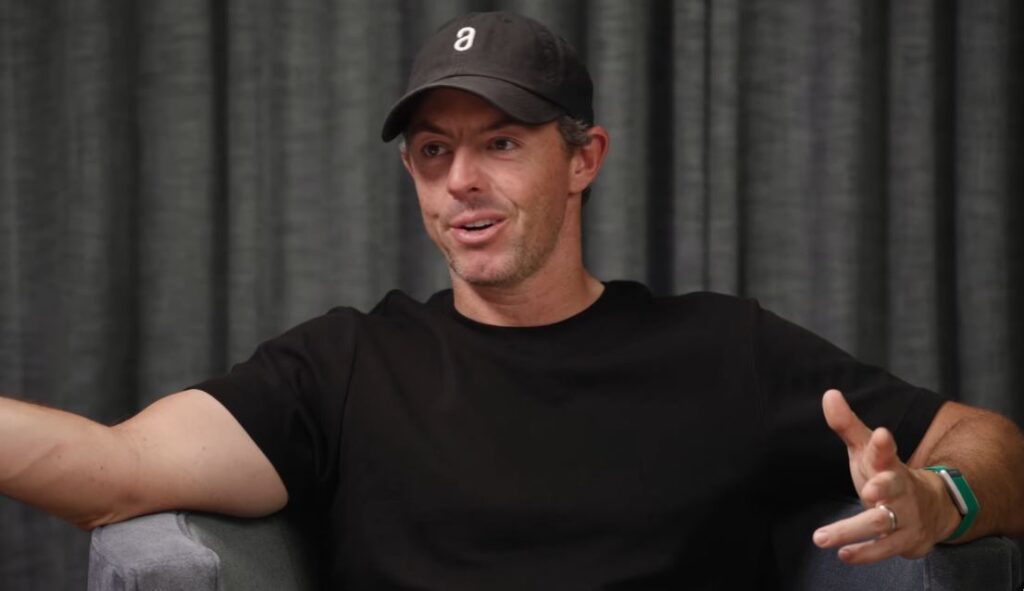The marriage that Rory McIlroy and Erica Stoll have maintained has remarkably withstood a year of upheaval and intense public scrutiny. From their happy beginnings in 2017 to their impending divorce in 2024, their relationship has proven remarkably strong. When McIlroy filed for divorce in May of last year, he shocked many by claiming that his marriage was “irretrievably broken,” a statement that at the time seemed to signal the end of the marriage. Amazingly, though, the two changed their minds in less than a month, silently patching what might have been irreparably broken.
Their reconciliation, which was finalized without dramatic announcements or public appearances, reflected the steady, grounded manner in which they have operated their relationship since the start. The emotional significance of McIlroy’s tearful embrace of his wife and daughter after winning one of golf’s most coveted titles during the 2025 Masters went well beyond the 18th hole. It represented a personal triumph, won out of sight of cameras and applauding spectators, where forbearance, perseverance, and resolve had significantly defeated hopelessness.
| Category | Details |
|---|---|
| Full Name | Rory Daniel McIlroy |
| Birth Date | May 4, 1989 |
| Nationality | Northern Irish |
| Profession | Professional Golfer |
| Spouse | Erica Stoll (married 2017) |
| Children | One daughter, Poppy Kennedy McIlroy |
| Reference | Wikipedia – Rory McIlroy |
Rory and Erica have greatly lessened the clamor that frequently surrounds celebrity couples by relying on emotional authenticity rather than staged headlines. Due to a digital culture that amplifies every rumor, the public’s interest in well-known relationships has increased dramatically over the last ten years. But what feels especially refreshing is McIlroy’s unwavering refusal to use his private life for public gain.
Their relationship, which has been put to the test and changed by hardship, is remarkably similar to the perseverance needed in high-level sports. Similar to modifying a swing in the middle of a competition, Rory refocused his priorities during personal upheaval, paying close attention to fostering mutual respect, trust, and emotional development.
Millions of people began working remotely during the pandemic, which forced couples to deal with an unprecedented level of intimacy. Many relationships broke down under that strain, but Rory and Erica‘s story shows that when discomfort is managed carefully, it can spur rebirth rather than breakup. Their decision to recover in private, away from the performative stage of social media, demonstrates a very effective strategy for preserving intimacy in a time when privacy frequently feels dangerously brittle.

The McIlroys provide a particularly creative model for celebrity relationships for medium-sized public spheres, such as golf fandoms, which prioritize substance over spectacle and humility over spectacle. The frequency and emotional visibility of their shared appearances have significantly increased in recent months, indicating a repaired foundation that was meticulously constructed through candid discussions rather than hollow apologies.
Rory and Erica have offered a positive story for young couples navigating contemporary pressures by working together on personal development and refusing to give up at the first hint of difficulty. Their tenacity teaches a very useful lesson: relationships can withstand setbacks as long as there is sufficient grace and a readiness to move on.
Few athletes in the history of sports have given fans such an open look into their emotional rebalancing as McIlroy has. After his marriage temporarily fell apart, he continued to play exceptionally well, winning the Masters and earning his career Grand Slam. It’s hard to ignore the link between his career comeback and his newfound personal clarity.
McIlroy has demonstrated through strategic alliances on and off the course how important it is to have real support networks, whether they be in the form of caddies, coaches, or friends, in order to maintain excellence. Erica’s experience in professional golf administration and her awareness of the pressures of tournament life have probably helped them regain stability.
Interest in McIlroy’s career and personal journey has grown dramatically since the announcement of their reconciliation, indicating that modern audiences prefer complex, relatable tales to sanitized, untouchable heroes. Rising, faltering, recalibrating, and finally thriving, his story arc has proven incredibly relatable in a society that frequently demands perfection but overlooks genuineness.
Rory McIlroy has shown that legacy is created not only through winning trophies but also through emotional development and moments of humility by fusing emotional honesty with athletic prowess. His story’s fabric feels incredibly resilient, bound together by intentional healing and shared adversity rather than ephemeral triumphs.
It’s anticipated that Rory’s reputation will grow in the upcoming years due to both his tournament victories and the emotional maturity he has so openly displayed. His once-fragile marriage now serves as a reminder that resilience is a sustained, deliberate decision made every day rather than a single act.
With her constant understatement, Erica continues to be the kind of partner whose strength is found in her remarkably steady presence rather than in her loud declarations. Their joint decision to construct a new home in London is a progressive move that demonstrates how sometimes both emotional and physical reinvention are necessary for growth.
